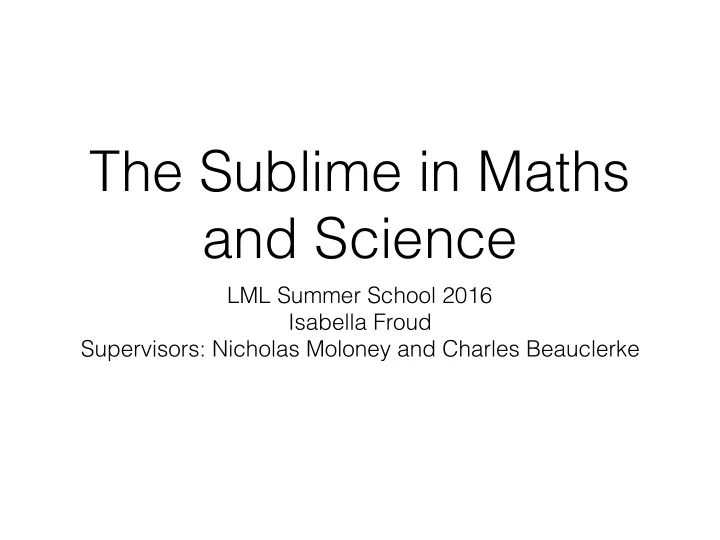

The Sublime in Maths and Science LML Summer School 2016 Isabella Froud Supervisors: Nicholas Moloney and Charles Beauclerke
Motivation • Sublime has meaning in both mathematics and philosophy • Are these descriptions referring to the same thing?
Key Aims • Understand the concept of a sublime experience in terms of philosophy • Establish compatibility of mathematics with this concept • Seek examples to corroborate findings
History of the Sublime • References date back to 1st century AD • Found in literature, art, science and is studied in philosophy • Philosophy tries to define a sublime experience • Pleasure stemming from displeasure: awe and fear
Immanuel Kant (1724-1804) • Analysed the sublime in 1760 and 1794 • Logical and systematic
Kant’s Aesthetics • Judgements without referral to a concept or prior notion • Beauty: purely pleasurable • Dynamical Sublime: fearful of the power of nature, whilst being safe • Mathematical Sublime: unable to comprehend magnitude, need to access a ‘super sensible faculty’ - Reason.
Process of Judgement: • Imagination ‘gives form’ to the sensory data, also called perception • Understanding applies a rule if imagination succeeds • Reason deals in principles, universals, totality
Process of Judgement: Beautiful Sublime
Mathematical Compatibility • Non-aesthetic: refer to purpose of object during judgement • Mathematical objects unable to be aesthetically judged • Intellectual pleasure instead
Beauty in Proofs - Angela Breitenbach (2013) • Breitenbach argues Kant allows for beauty in mathematics • Beauty is not in mathematical objects, or their properties • BUT demonstration or proof of a property can be beautiful i.e. the judgement is aesthetic
Two types of Infinity • Potential: unbounded, limitless, accepted • Actual: complete, whole, controversial Image from: “Potential versus Completed Infinity: its history and controversy” - E. Schechter
Using Infinities: Cantor • Potential infinities relate to imagination failing to delimit • Actual infinities relate to reason: condense an ungraspable idea into a neat package • Georg Cantor’s diagonalization argument: defending actual infinities
Criteria: • Aesthetic: avoiding concepts? • Imagination: spontaneous? • Purposiveness: imagination succeeds or fails in delimiting? Success: all Failure: cannot integers contained contain integers
Counting • Countability is equivalent to being able to write a numbered list of all the elements in a set
The Rational Numbers • Arrange rational numbers in a grid • Horizontal counting: will run out of natural numbers before reaching second row
The Rational Numbers • Suddenly notice counting along finite diagonals • Able to assign natural number to every rational
Beauty in this Proof • Aesthetic: not relying on concept of numbers • Imagination: jump to diagonal path seems spontaneous • Purposiveness: have successfully ‘caught’ every rational
Cantor Diagonalization 1. 0 . 1 1 1 1 1 2. 1 . 4 1 4 2 1 • What about the real numbers? 3. 3 . 1 4 1 5 9 • Assumption: every real 4. 1 . 7 3 2 0 5 number is included in this list 5. 0 . 1 2 5 1 6 6. 2 . 5 7 3 3 8
Cantor Diagonalization 1. 0 . 1 1 1 1 1 • Notice diagonal entries 2. 1 . 4 1 4 2 1 • Take number x, consisting of these digits: x=0.44218… 3. 3 . 1 4 1 5 9 • Choose a number y such that y shares no digits with x, e.g. 4. 1 . 7 3 2 0 5 y=1.73602… 5. 0 . 1 2 5 1 6 • Conclusion: y not in list i.e. the real numbers are uncountable 6. 2 . 5 7 3 3 8
Sublimity in this Proof • Imagination has failed to delimit the rational numbers - pain • Aesthetic: only using ‘same’/‘not same’, not properties of numbers • Reason stops process by creating new principle that some infinitely large sets are bigger than others
Key Discoveries • Imagination is stuck in an iterative loop • Cantor diagonalization used in Gödel’s Theorem, the Halting Problem • Halting Problem relates to aesthetic process
Morality? • Kant: sublime experience makes you aware of your moral purpose • Mathematically sublime proofs may not be moral in the typical sense • Mathematician may act ‘morally’ by supplying a sublime proof [See: Cheng]
Conclusion: • Some mathematical proofs can provoke sublime experiences • These experiences are aesthetically grounded in the Kantian sense • Problem of accommodating morality
Questions? Thank you for listening
Sources • Image: http://www.math.vanderbilt.edu/~schectex/ courses/thereals/potential.html • A. Breitenbach: Beauty in Proofs • W. P. Thurston: On Proof and Progress in Mathematics • E. Cheng: Mathematics, morally
Further Reading • J. W. Dauben: Georg Cantor, His Mathematics and Philosophy of the Infinite • R. Goldstein: Incompleteness, The Proof and Paradox of Kurt Gödel • W. Byers: How Mathematicians Think
Recommend
More recommend